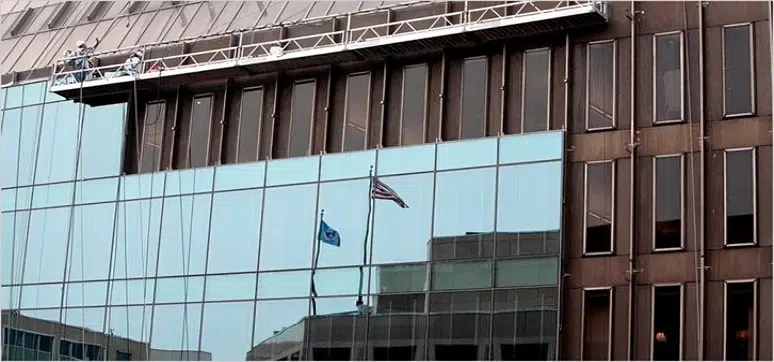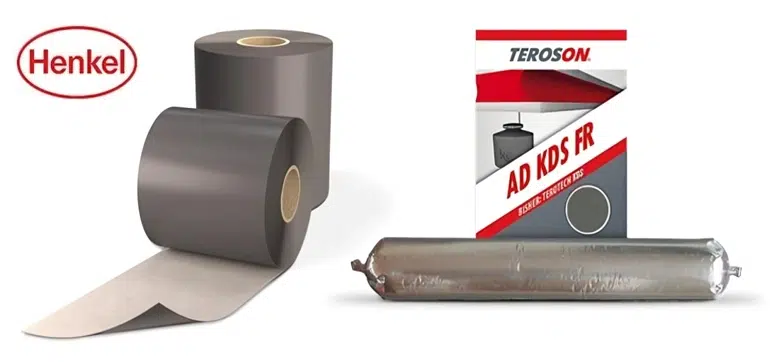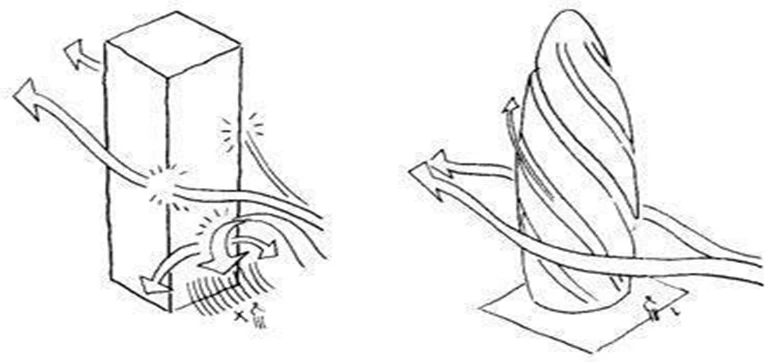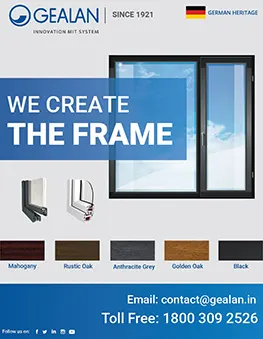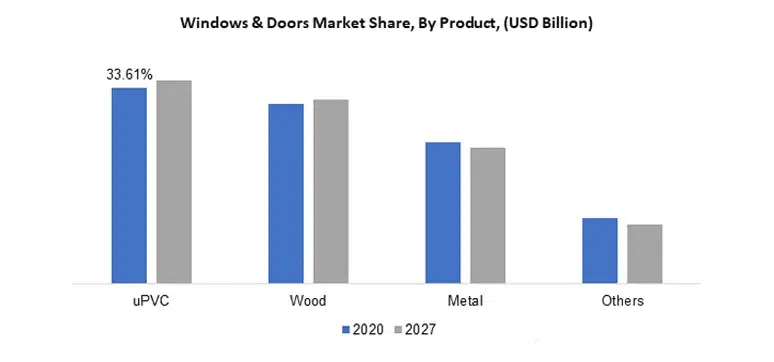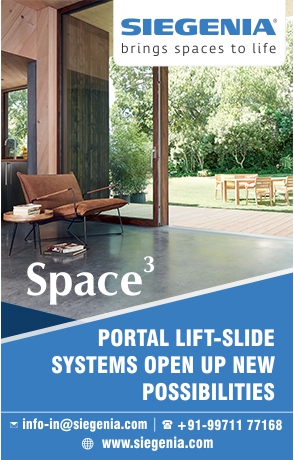DE-Coding NFPA 285
By:
In recent decades, with the desire for taller structures and with a strive for improved energy efficiency by adding exterior insulation, we sometimes encounter potential conflicts with fire and life safety codes. With the popularity of building certification programmes net-zero energy building initiatives to the active building enclosure movement, expectations continue to increase for building performance, facility life, and occupant health and safety. Because two of the most critical aspects of high-performance buildings are air/water tightness and the enclosure’s thermal performance, the necessity of using more insulation, and high-quality air/water barrier and flashing materials, will continue to increase as the industry trends toward highly energy-efficient building envelopes. With time when it was realised that combustible material was being used in large quantities in exposed areas, code officials and manufacturers got together and established codes and policies to protect life safety. In the process, the required testing of wall assemblies paved the way for what was to become the NFPA 285 test. As codes and terminology have become more technical and complex, this lack of understanding of the basics continues to feed an age-old problem. To start with, let’s understand the difference between ‘Reaction to Fire’ and ‘Fire Resistance’.
Difference between Fire Resistance and Reaction to Fire
Regulation requires the fire performance of construction materials to be considered and in simplistic terms, the building components must not contribute to the ignition and spread of a fire, whilst the fabric elements must be resistant to fire in terms of their ability to provide the necessary structural and [fire] separation functions. Designs to achieve these requirements typically call upon two types of fire test data – Reaction to Fire and Fire Resistance.
The former describes the combustibility characteristic of building materials, the latter describes the period for which particular construction can resist exposure to a specified fire load, whilst maintaining its form and function. A major difference between buildings built today and those built as recently as 50 years ago is the level of thermal insulation. The thermal benefits of insulation are well understood, however, consideration must be given to the effect of its presence both in terms of the Reaction to Fire characteristics and the impact of high fabric insulation values on structures when involved in a fire.

Reaction to Fire classification is now largely based upon the European Standard EN 13501-1 giving European classes, or ‘Euroclasses’ and for most building materials, it is determined from a combination of four tests. There are seven levels of classification A1 (non-combustible), A2 (limited combustibility), B, C, D, E and F. A1 is the highest performance and F is the lowest.
From the Reaction to Fire classification, the critical thing to note is that the nature of the testing changes from classes A1 and A2, where the focus is to show that a product is non-combustible, whereas for classes B and below the focus is on the degree of combustibility.
Where Reaction to Fire looks at a material’s individual properties, Fire Resistance classification relates to how building elements, including specifically purposed fire protection products, and their installation, can be expected to behave in the event of a fire. Fire protection classifications are commonly reported in terms of a period of fire resistance, for example, 30 minutes. The classifications relate to integrity (E), thermal insulation (I) and load-bearing capacity (R) either singly or in combination. In simple terms where a fire occurs, stopping it spreading (E), restricting the temperature rise on the opposing side of the element (I), and maintaining the elements load bearing capacity (R). The test methods are defined in British Standards (BS) which determine the conditions of the test as well as the preparation of the test element.
The classification is carried out according to the BS 476 suite of standards (or BS EN 13501-2) which closely defines how to interpret the test results and arrive at the period of fire protection. Different building elements (purposed for the same application) may include insulation materials with different reactions, to fire characteristics and yet still achieve the same fire resistance classification.
The Purpose of NFPA 285
NFPA 285 is specified in the International Building Code for determining the flammability characteristics of exterior non-load bearing wall assemblies and panels used as components of curtain wall assemblies, construction using combustible materials, or that incorporate combustible components that are intended to be installed on buildings required to have exterior walls of non-combustible construction. This means that, except for some one-storey buildings, foam plastics cannot be used in these applications unless they are tested to and pass NFPA 285. Expanded polystyrene, extruded polystyrene and polyisocyanurate insulation products classified as foam plastic insulation for exterior applications must pass NFPA 285-2012. In order to be accepted as a code-compliant exterior ‘wall assembly’ two-storey full-scale mockups had to be built and tested for flame spread.
I underline ‘assembly’ because it is important to stress that it is not individual materials that pass, but rather the full make-up of the exterior wall. Fire is a funny thing and it will act differently if the slightest change is made in these assemblies. Switching the order of materials, switching manufacturers (thus switching formulations) or even enlarging an air gap can change the outcome of the testing.
What It Means For The Consultant?
Façade consultants in this case find themselves in a difficult position, as they are aware of the code language. They must say something about the noncomplying situations. Often, however, the architect doesn’t want to hear that his wall does not meet the code. First, it makes the architect look bad, as he or she should have known about the code, and, second, it is likely to disrupt the project schedule and budget—sacrilege in the best of circumstances. Finally, it is often hard to convince an architect that anything is amiss if the plans examiner is not even aware of the problem.
One of the reasons the issue has not received more attention is probably because of the lack of actual, centralised, documentable problems resulting from the use of foam plastic insulation in the exterior wall system. With more and more buildings being built with untested foam plastic insulation assemblies, the possibility of real damage from fire constantly grows. And, as with most code issues, the architect is ultimately responsible.
The code official, while charged with enforcement, has no legal liability. It does not matter if the issue was completely ignored in the plan check. The reality is that the architect (and the general contractor for that matter) is responsible for designing and constructing a building according to the code. Architects are constantly working with increasingly tighter fees and schedules on ever more complex projects. Continuous insulation is a good example of greater complexity. The building enclosure gets more complex as continuous insulation causes the cladding to be farther offset from the sheathing.
Thermal bridging adds to the difficulty of designing a cladding attachment system that must span the insulation, minimise heat transfer and structurally support the cladding. If foam plastic insulation is used, details around openings must be carefully designed to proven standards that have passed NFPA 285. Mineral wool insulation is an alternative to foam plastic. It eliminates the need for fire testing altogether.
In order to meet the requirements for using foam plastics in a wall system, the assembly must pass NFPA 285. The individual materials are not being tested as much as the entire assembly, including installation. Once an assembly has passed (at a cost of AED 1,50,000), any substitution of sheathing, weather barrier, insulation, cladding, etc., requires another test or, at least, an engineering judgment.
Whereas Exterior Insulation Finish Systems (EIFS) systems are typically furnished by a single manufacturer. This simplifies the problems encountered in meeting NFPA285. An EIFS manufacturer can design a system that passes the test and then can supply every material in the assembly to ensure that it is built to code. On the other hand, cavity walls are normally an assembly of separate parts put together by separate trades. In order to keep costs competitive, the desire is to provide performance specifications for as many of the materials in an assembly as possible. Strict adherence to the make and model of each component in a tested assembly removes much of the latitude that allows for the development of performance-based specifications rather than identifying proprietary wall assemblies that discourage competitive bidding.
Architects need to be able to design wall systems with a reasonable amount of flexibility and confidence while meeting or exceeding the minimum code requirements. One solution for adding flexibility to the specification process is to move toward a list of approved assemblies (such as an Underwriters Laboratories or Thomas Bell-Wright International Consultants list) in order to encourage competitive bidding. This would allow the architect to specify performance rather than product. Further education, discussion and review are necessary to attain reasonable, economical solutions to our enclosure challenges while remaining sensitive to life safety issues.
How Does NFPA 285 Affect the Work of General Contractors?
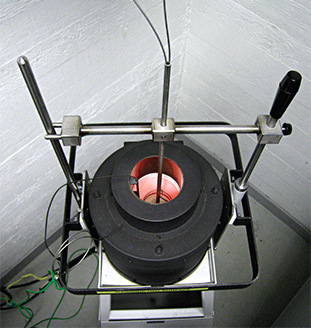
A contractor’s perspective on the code is heavily influenced by how it affects their ability to successfully deliver work to their clients. Changes to the code that affect the three constraints of project delivery (cost, schedule and quality) must be fully understood by the design and construction team in order to plan for and/or mitigate the impact of those changes.
NFPA 285 is an assembly test, not a component test. As such, the entire assembly, with each specified material, is required to create a compliant assembly. This means that neither the designer, general contractor nor subcontractors can substitute materials into this assembly—to do so would render it non-compliant. Each assembly tested according to NFPA 285 is therefore a proprietary assembly.
Proprietary assemblies lock contractors into specific materials, often requiring installation by a select few installers. This is a clear advantage for those installers and their price reflects the fact that competition has been greatly reduced by the use of proprietary assemblies. Generic assemblies tend to allow the contractor and subcontractors to bring value to the table and help to create competitive bidding. In our current economic climate, being cost-competitive is essential to landing the job, so they must look for options to meet the increasing demands for energy-efficient assemblies. Using mineral wool in lieu of foam plastic insulation is one option currently considered by most of the companies involved in the design and consulting industries. Mineral wool insulation has been used extensively in Europe and Canada for some time and is often used throughout the United States for fire saving and other interior uses.
There are clear cost implications to the inclusion of foam plastic insulation in exterior assemblies. They include not only the cost of the insulation itself but also additional materials and detailing around openings to allow cladding to return to doors and windows. There is a schedule implication in that exterior insulation is another layer to be added to the building envelope, a layer that must be well-detailed to be most effective, requiring more attention to detail (and therefore time) than installing traditional non-combustible insulation.
Incorporating pretested assemblies into The Design
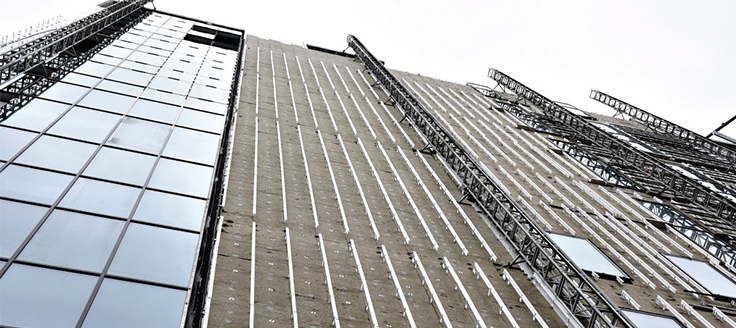
Best practices for designing efficient, high performing exterior wall systems include continuous insulation and various barriers to meet energy code requirements, reduce thermal bridging and provide resistance to water penetration and excessive air infiltration and vapour migration. However, the designer is challenged to find a passing NFPA 285 test assembly that incorporates all of the components and features of these high-performing wall systems. The following should be considered when selecting components and designing the details of exterior walls that require testing to NFPA 285:
Foam Plastic Insulation:
Several foam plastic insulation products have been tested as part of wall assemblies that have passed the NFPA 285 test. However, designers specifying such products need to be aware of the specific details of the tested assembly and thus the limitations of the test report. For example, the thickness of the foam plastic used in the test is a maximum; designers wanting to use a greater amount would have to retest or otherwise justify the increase. Designers also need to be aware of the type of air, vapour and/or water-resistive barriers included in the test.
Non-Combustible Mineral Wool Insulation: This is an alternative to foam plastic insulation that does not trigger the NFPA 285 testing requirement (unless another combustible material is included in the wall assembly).
Combustible Cladding Materials: Several combustible cladding materials have passed the NFPA 285 test. However, designers should be aware of the limitations of the given test assembly. For example, combustible cladding materials are often tested only with non-combustible insulation and without an air, vapour and/or water-resistive barrier. Therefore, designers wanting to include combustible insulation and/or air, vapour and/ or water-resistive barrier need to verify that these components are included in an existing test assembly or pursue new testing (and incurred project costs) or other justification for including these components.
Window Head Detail: Many successfully tested NFPA 285 wall assemblies include a firestop at the window head, such as mineral wool or structural steel. These details, as tested, can be difficult to incorporate into exterior wall designs. The following should be considered when incorporating such firestop details into the design:
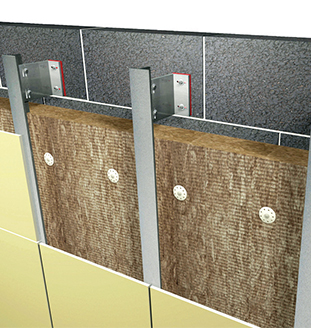
- The continuity of the air, vapour and water resistive barriers from the field of the wall to the window
- Potential for thermal bridging with steel stops
- Drainage of water from the wall cavity.
- Durability of materials
Conclusions
Compliance with NFPA 285 does not mitigate the need for engineering fire hazard and fire risk assessments. Architects, designers and specifiers need to be cognizant of the dangers associated with the presence of combustible materials in building assemblies. The performance of exterior walls during fire exposure is a critical element of building construction. Steel, concrete, masonry, gypsum and mineral wool are the materials of choice when fire performance and the presence of combustible materials within the building envelope are of concern.
Top Stories
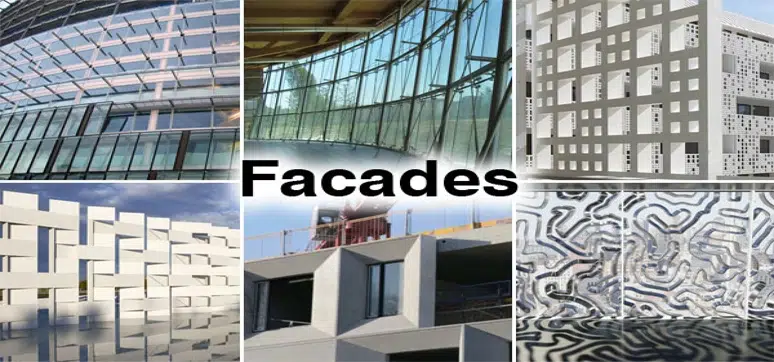
Façade Systems Market Size is Estimated to Reach USD 398.8 Billion by 2029
By: Abdul | April 16, 2024
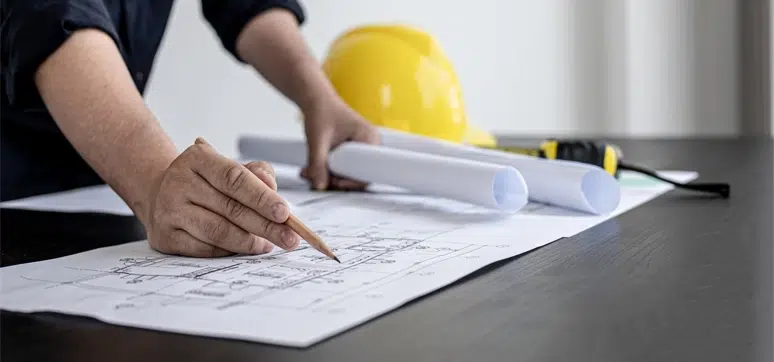
Improving Sustainability Alongside Fire Safety – Can We Deliver?
By: Abdul | April 16, 2024

Foster + Partners Wins the Competition the New Xicen Science & Technology Centre
By: Abdul | April 9, 2024

A Symbol of Architectural Brilliance & Cultural Significance
By: Abdul | April 8, 2024




